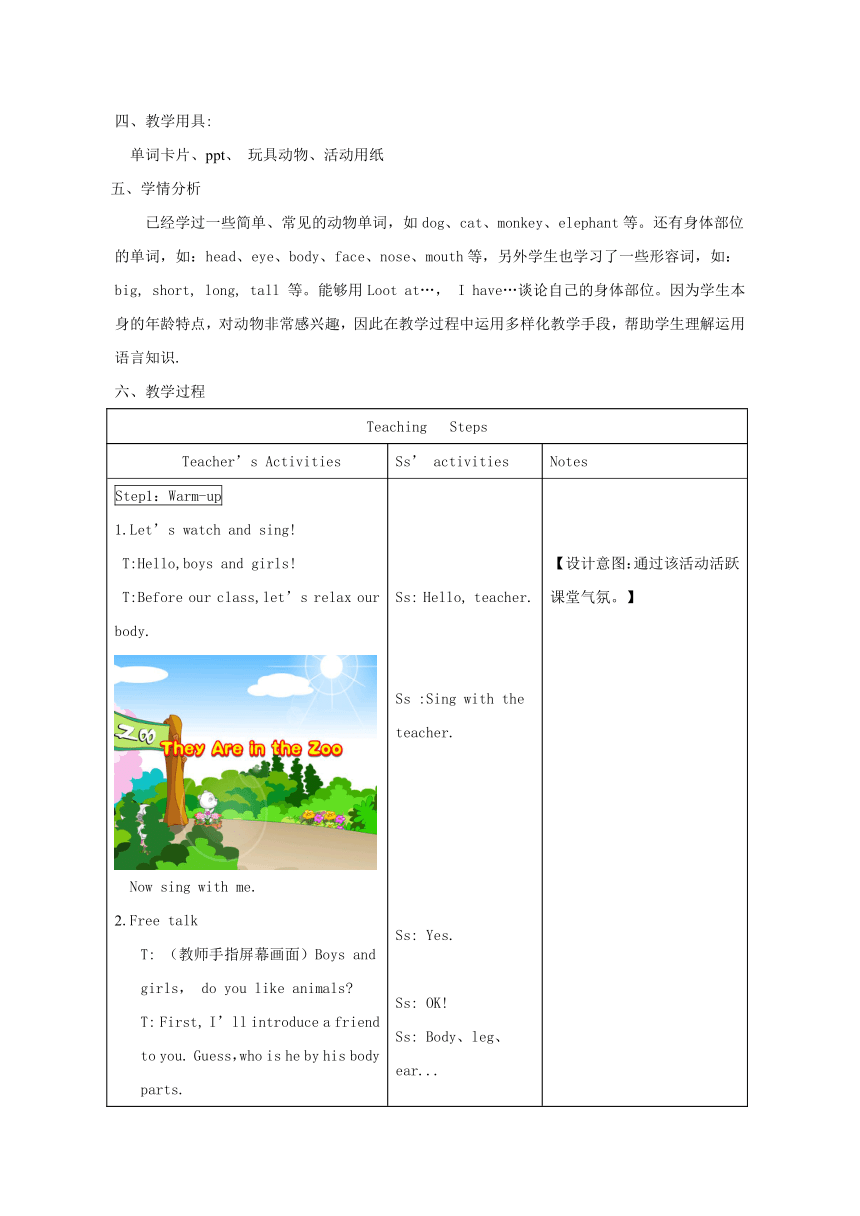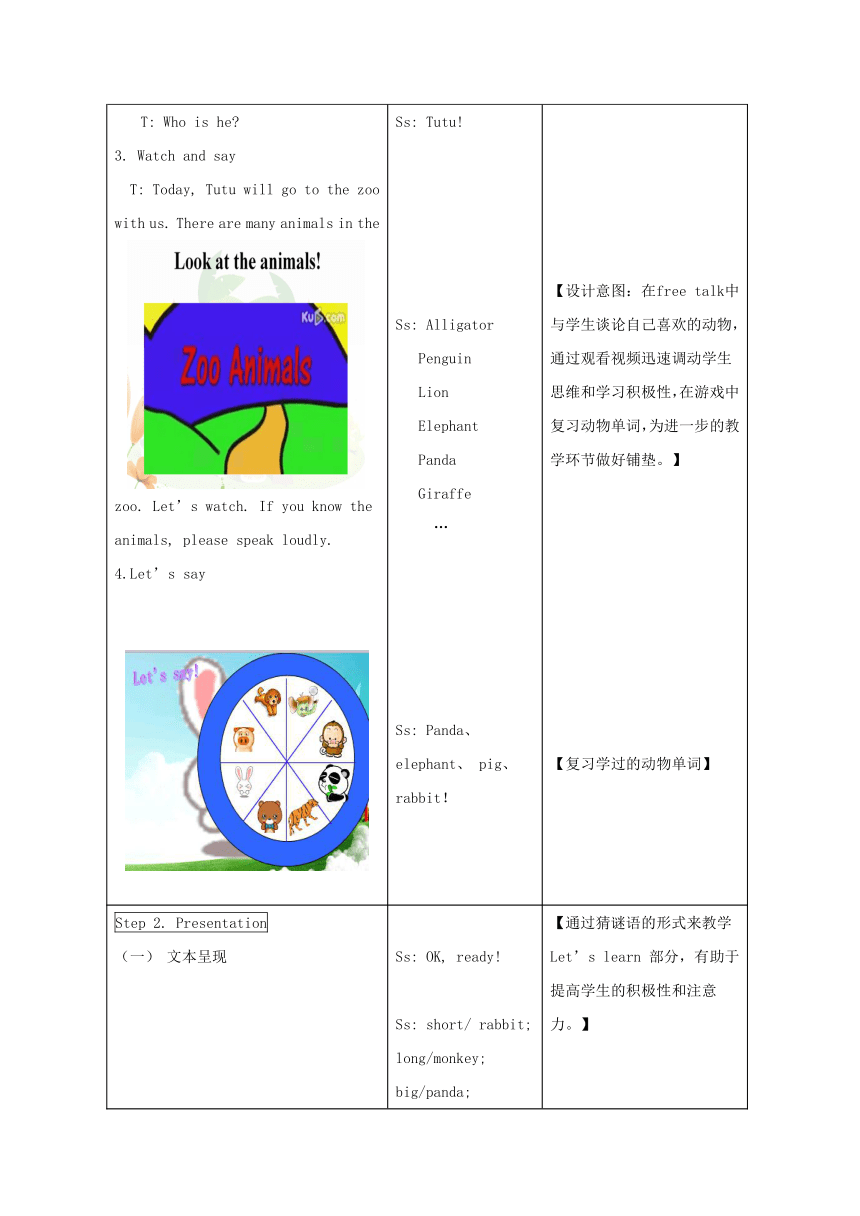Unit 3 At the zoo PB Let’s learn & Let’s talk 教案
文档属性
| 名称 | Unit 3 At the zoo PB Let’s learn & Let’s talk 教案 |  | |
| 格式 | zip | ||
| 文件大小 | 3.5MB | ||
| 资源类型 | 教案 | ||
| 版本资源 | 人教版(PEP) | ||
| 科目 | 英语 | ||
| 更新时间 | 2019-07-19 08:54:38 | ||
图片预览



文档简介
PEP3下册Unit3 At the zoo
Part B Let’s learn & Let’s talk
一、教学内容:
本节课主要学习big、small、short、long四个单词,通过Miss White, John, Mike 与陈杰在动物园看大象的语境呈现了核心句型:It has …。教学目标是要求学生能够正确听、说、认、读单词:small, big, long, short;能够理解对话大意,能够用正确的语音语调朗读对话,并能够在语境中区分和运用“It has a +形容词+单数身体部位”和“It has+形容词+复数身体部位”的句型。
二、教学目标:
1. 知识目标:
(1)能够听、说、认读单词:long、short、small、big
(2)能够听懂、会说并认读句型It has …
(3)能够听懂、会说单词:children、tail
2.能力目标:
能够在图片、实物或情景的帮助下运用句型It has …描述动物并听懂别人的描述。
3. 情感态度、文化意识:具有热爱动物、保护动物的意识,不乱逗玩动物或乱投喂动物等。
三、教学重点,难点:
抓住动物特征,用含有简单形容词的句子来进行描述。
四、教学用具:
单词卡片、ppt、 玩具动物、活动用纸
五、学情分析
已经学过一些简单、常见的动物单词,如dog、cat、monkey、elephant等。还有身体部位的单词,如:head、eye、body、face、nose、mouth等,另外学生也学习了一些形容词,如:big, short, long, tall 等。能够用Loot at…, I have…谈论自己的身体部位。因为学生本身的年龄特点,对动物非常感兴趣,因此在教学过程中运用多样化教学手段,帮助学生理解运用语言知识.
六、教学过程
Teaching Steps
Teacher’s Activities
Ss’ activities
Notes
Step1:Warm-up
1.Let’s watch and sing!
T:Hello,boys and girls!
T:Before our class,let’s relax our body.
Now sing with me.
2.Free talk
T: (教师手指屏幕画面)Boys and girls, do you like animals?
T: First, I’ll introduce a friend to you. Guess,who is he by his body parts.
T: Who is he?
3. Watch and say
T: Today, Tutu will go to the zoo with us. There are many animals in the zoo. Let’s watch. If you know the animals, please speak loudly.
4.Let’s say
Ss: Hello, teacher.
Ss :Sing with the teacher.
Ss: Yes.
Ss: OK!
Ss: Body、leg、ear...
Ss: Tutu!
Ss: Alligator
Penguin
Lion
Elephant
Panda
Giraffe
…
Ss: Panda、 elephant、 pig、rabbit!
【设计意图:通过该活动活跃课堂气氛。】
【设计意图:在free talk中与学生谈论自己喜欢的动物,通过观看视频迅速调动学生思维和学习积极性,在游戏中复习动物单词,为进一步的教学环节做好铺垫。】
【复习学过的动物单词】
Step 2. Presentation?
文本呈现
T:OK, let’s learn some new words. Guess! Ready?
T: short、long、big 、small
It has...
Look at...(板书)
T: Let’s see what the ostrich look like.
T:Today, our friends and Miss White are also going to the zoo. Let’s follow them and tell me what animal can you see?
T: We can say: I see the elephant.
T: Come here...(板书)
创设情境,认识大象
T:Look, this is our new friend elephant. The elephant wants to make friend with us. Now she is introducing herself.
T: Do you know our new friend?
T: OK! Now I have a question. What does the elephant look like? You can use this sentence. It has…(板书)
教师带学生加动作一起复习3句话,并强调a long nose,a short tail,big ears。
再次呈现文本,并教学课文
1. Listen and repeat
跟读句子并学习:单词Children和句子 It has small eyes and big ears.
2. Open books and repeat again.
3. Read the dialogue in groups
4.Circle and underline the important points.
5. Role play.
6. Show time.
Ss: OK, ready!
Ss: short/ rabbit; long/monkey; big/panda; small/elephant.
Ss: a small head, a big body, a short tail, long legs.
S1: Elephant.
Ss: The elephant
Together
One by one
Ss: Listen carefully.
Ss: Yes.
S1:It has a long nose.
S2: It has a short tail.
S3: It has big ears. (黑板呈现)
1st Listen
2nd Chant together
Listen and repeat
Repeat again.
Read together.
Act the dialogue.
【通过猜谜语的形式来教学Let’s learn 部分,有助于提高学生的积极性和注意力。】
【设计意图:较早呈现文本,让学生对文本整体感知,同时引出the elephant,解决发音问题。在和学生交流时运用Look at … 帮助学生回忆旧知】
【设计意图:通过认识了解新朋友的环节,让学生通过听、看初步学习It has…,并尝试着描述新朋友的特点,环环紧扣,引起学生的兴趣。】
【设计意图:学生通过听录音,分角色读对话,表演对话等形式进一步理解对话内容,并借助板书降低对话表演的难度。】
Step3. Consolidation and extension
Let’s check.
听录音,猜动物
Let’s chant.
T: Chant together.
德育渗透
T: Boys and girls. When we are in the the zoo, don't feed the animals. Please remember. OK?
Let’s practice
T:Choose the animal which you like best and give it a △。
Let’s check
Ss: A,B, short, long.
Listen and guess
S1: Tiger.
S2: Rabbit.
S3: Panda.
S4: Elephant.
Ss: Chant with the music.
Ss:OK
Ss: 积极踊跃地参与。
【设计意图:通过简单而又有针对性的练习,通过听录音猜动物的游戏活动进一步巩固本节课的重点内容,同时给下一步的环节提供语言样本,提升学生语言交际的能力。】
【设计思路:在学生描述完小动物之后,通过教师总结,自然引出Don’t feed the animals in the zoo.这一德育目标。】
【活跃课堂气氛,调动学生的自主性。】
Homework
任意选择两种自己喜欢的小动物,用今天所学的英语知识描述给自己的父母听。
Blackboard design
Unit 3 At the zoo
Come here... short long
Look at...
It has... big small
Part B Let’s learn & Let’s talk
一、教学内容:
本节课主要学习big、small、short、long四个单词,通过Miss White, John, Mike 与陈杰在动物园看大象的语境呈现了核心句型:It has …。教学目标是要求学生能够正确听、说、认、读单词:small, big, long, short;能够理解对话大意,能够用正确的语音语调朗读对话,并能够在语境中区分和运用“It has a +形容词+单数身体部位”和“It has+形容词+复数身体部位”的句型。
二、教学目标:
1. 知识目标:
(1)能够听、说、认读单词:long、short、small、big
(2)能够听懂、会说并认读句型It has …
(3)能够听懂、会说单词:children、tail
2.能力目标:
能够在图片、实物或情景的帮助下运用句型It has …描述动物并听懂别人的描述。
3. 情感态度、文化意识:具有热爱动物、保护动物的意识,不乱逗玩动物或乱投喂动物等。
三、教学重点,难点:
抓住动物特征,用含有简单形容词的句子来进行描述。
四、教学用具:
单词卡片、ppt、 玩具动物、活动用纸
五、学情分析
已经学过一些简单、常见的动物单词,如dog、cat、monkey、elephant等。还有身体部位的单词,如:head、eye、body、face、nose、mouth等,另外学生也学习了一些形容词,如:big, short, long, tall 等。能够用Loot at…, I have…谈论自己的身体部位。因为学生本身的年龄特点,对动物非常感兴趣,因此在教学过程中运用多样化教学手段,帮助学生理解运用语言知识.
六、教学过程
Teaching Steps
Teacher’s Activities
Ss’ activities
Notes
Step1:Warm-up
1.Let’s watch and sing!
T:Hello,boys and girls!
T:Before our class,let’s relax our body.
Now sing with me.
2.Free talk
T: (教师手指屏幕画面)Boys and girls, do you like animals?
T: First, I’ll introduce a friend to you. Guess,who is he by his body parts.
T: Who is he?
3. Watch and say
T: Today, Tutu will go to the zoo with us. There are many animals in the zoo. Let’s watch. If you know the animals, please speak loudly.
4.Let’s say
Ss: Hello, teacher.
Ss :Sing with the teacher.
Ss: Yes.
Ss: OK!
Ss: Body、leg、ear...
Ss: Tutu!
Ss: Alligator
Penguin
Lion
Elephant
Panda
Giraffe
…
Ss: Panda、 elephant、 pig、rabbit!
【设计意图:通过该活动活跃课堂气氛。】
【设计意图:在free talk中与学生谈论自己喜欢的动物,通过观看视频迅速调动学生思维和学习积极性,在游戏中复习动物单词,为进一步的教学环节做好铺垫。】
【复习学过的动物单词】
Step 2. Presentation?
文本呈现
T:OK, let’s learn some new words. Guess! Ready?
T: short、long、big 、small
It has...
Look at...(板书)
T: Let’s see what the ostrich look like.
T:Today, our friends and Miss White are also going to the zoo. Let’s follow them and tell me what animal can you see?
T: We can say: I see the elephant.
T: Come here...(板书)
创设情境,认识大象
T:Look, this is our new friend elephant. The elephant wants to make friend with us. Now she is introducing herself.
T: Do you know our new friend?
T: OK! Now I have a question. What does the elephant look like? You can use this sentence. It has…(板书)
教师带学生加动作一起复习3句话,并强调a long nose,a short tail,big ears。
再次呈现文本,并教学课文
1. Listen and repeat
跟读句子并学习:单词Children和句子 It has small eyes and big ears.
2. Open books and repeat again.
3. Read the dialogue in groups
4.Circle and underline the important points.
5. Role play.
6. Show time.
Ss: OK, ready!
Ss: short/ rabbit; long/monkey; big/panda; small/elephant.
Ss: a small head, a big body, a short tail, long legs.
S1: Elephant.
Ss: The elephant
Together
One by one
Ss: Listen carefully.
Ss: Yes.
S1:It has a long nose.
S2: It has a short tail.
S3: It has big ears. (黑板呈现)
1st Listen
2nd Chant together
Listen and repeat
Repeat again.
Read together.
Act the dialogue.
【通过猜谜语的形式来教学Let’s learn 部分,有助于提高学生的积极性和注意力。】
【设计意图:较早呈现文本,让学生对文本整体感知,同时引出the elephant,解决发音问题。在和学生交流时运用Look at … 帮助学生回忆旧知】
【设计意图:通过认识了解新朋友的环节,让学生通过听、看初步学习It has…,并尝试着描述新朋友的特点,环环紧扣,引起学生的兴趣。】
【设计意图:学生通过听录音,分角色读对话,表演对话等形式进一步理解对话内容,并借助板书降低对话表演的难度。】
Step3. Consolidation and extension
Let’s check.
听录音,猜动物
Let’s chant.
T: Chant together.
德育渗透
T: Boys and girls. When we are in the the zoo, don't feed the animals. Please remember. OK?
Let’s practice
T:Choose the animal which you like best and give it a △。
Let’s check
Ss: A,B, short, long.
Listen and guess
S1: Tiger.
S2: Rabbit.
S3: Panda.
S4: Elephant.
Ss: Chant with the music.
Ss:OK
Ss: 积极踊跃地参与。
【设计意图:通过简单而又有针对性的练习,通过听录音猜动物的游戏活动进一步巩固本节课的重点内容,同时给下一步的环节提供语言样本,提升学生语言交际的能力。】
【设计思路:在学生描述完小动物之后,通过教师总结,自然引出Don’t feed the animals in the zoo.这一德育目标。】
【活跃课堂气氛,调动学生的自主性。】
Homework
任意选择两种自己喜欢的小动物,用今天所学的英语知识描述给自己的父母听。
Blackboard design
Unit 3 At the zoo
Come here... short long
Look at...
It has... big small
